Tuesday, May 11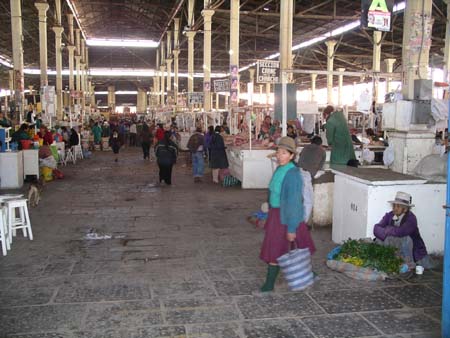
Paula: We spent the day exploring Cusco. With a population today of 320,000, this city was originally the political capital of the Inca Empire.
We started our day at the local market. We always find this a great way to
begin discovering the flavor of a community, and we found Cusco's market to
be wonderful. Hilda told us that 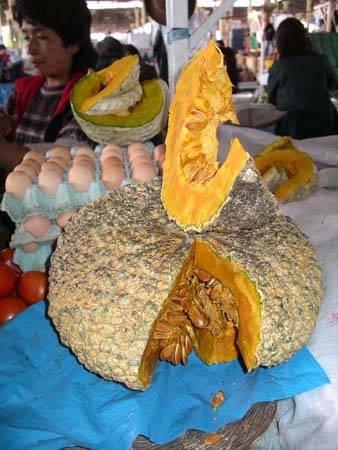 along
with most other residents of Cusco, this is the primary place that she shops
for daily needs.
along
with most other residents of Cusco, this is the primary place that she shops
for daily needs.
We immediately were able to identify products sold here that we have not
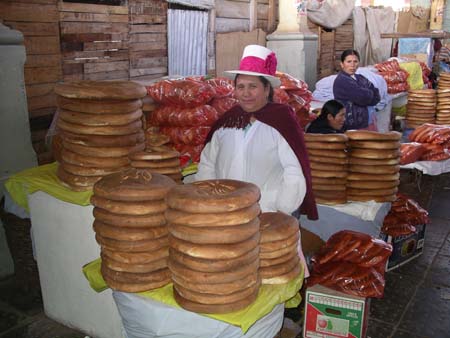 seen
in other markets that we have visited. Many varieties of fresh fruit juices
are available as well as other medicinal soups and drinks. For example, Maca
is an energy drink made from bamboo or potatoes and fondly referred to as
"Andean Viagra." Toad soup is sold mixed with a variety of herbs
dependin
seen
in other markets that we have visited. Many varieties of fresh fruit juices
are available as well as other medicinal soups and drinks. For example, Maca
is an energy drink made from bamboo or potatoes and fondly referred to as
"Andean Viagra." Toad soup is sold mixed with a variety of herbs
dependin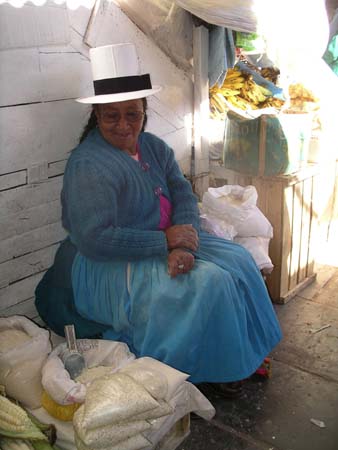 g
on your ailment. We also saw many varieties of potatoes (some dried), vegetables
and fruits, and strange pumpkins (like the one pictured here), with several
of the foods coming directly from the Amazon.
g
on your ailment. We also saw many varieties of potatoes (some dried), vegetables
and fruits, and strange pumpkins (like the one pictured here), with several
of the foods coming directly from the Amazon. 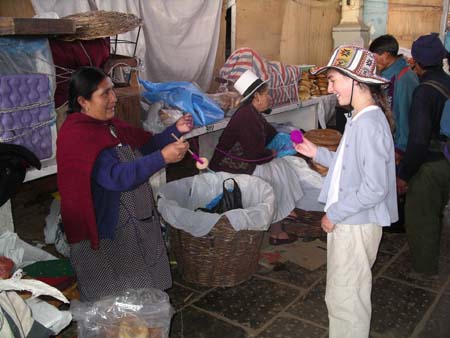
Bread is an important staple in Peru, and there are two major varieties sold here. Pan Jurca is a special round loaf that is often used as payment in exchange for services, and Chuta is flat bread eaten at breakfast and also used as a type of birthday cake.
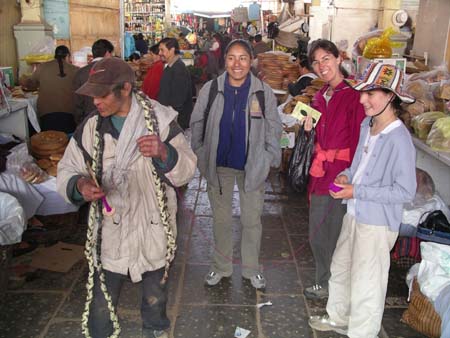
Katie attracted a lot of attention in the market today. Hilda has taught
her how to use a hand spinner and she decided to try walking and spinning
wool like the local women do. The women in the market were delighted to see
her practicing this skill and everyone 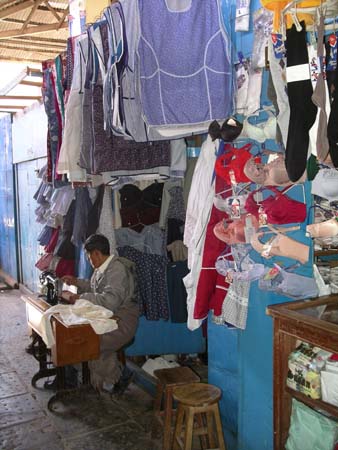 offered
suggestions and demonstrations. At one point we met a colorful farmer from
Paucartambo, a community at the entrance of the jungle. He insisted on proving
to Katie that he could spin and put on quite a show.
offered
suggestions and demonstrations. At one point we met a colorful farmer from
Paucartambo, a community at the entrance of the jungle. He insisted on proving
to Katie that he could spin and put on quite a show.
The market had the usual selection of fresh meats, but in addition we found
a whole separate section just for internal organs! Near this area, there were
many small kitchens offering soups made with the organs. Textiles and other
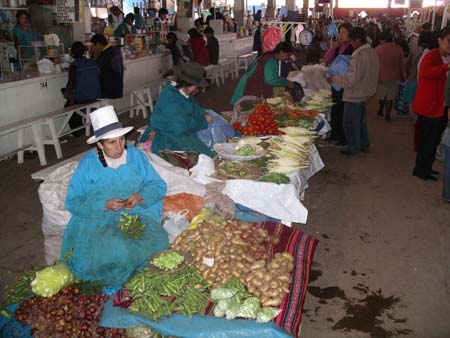 handicrafts
are also sold in the market and we bargained for several clothing items. We
watched as many tailors sat at old Singer sewing machines operated by manual
foot pedals. We also found it interesting to see the herbs and pottery purchased
to make offerings to "mother earth."
handicrafts
are also sold in the market and we bargained for several clothing items. We
watched as many tailors sat at old Singer sewing machines operated by manual
foot pedals. We also found it interesting to see the herbs and pottery purchased
to make offerings to "mother earth."
The rest of the day we spent exploring Cusco's historical past and surrounding
Inca ruins. Cusco was considered the "navel of the earth" by the
Incas and thus the capital of their universe. Their conquests were measured
in all directions from Cusco. Cusco is an interesting architectural mix of
Inca walls and foundations with Spanish alterations. The central square (Plaza
de Armas) with its surrounding churches looks very Spanish. Shops and restaurants
in the square all have Spanish terraces and arches, and we all agreed that
it is one of the pre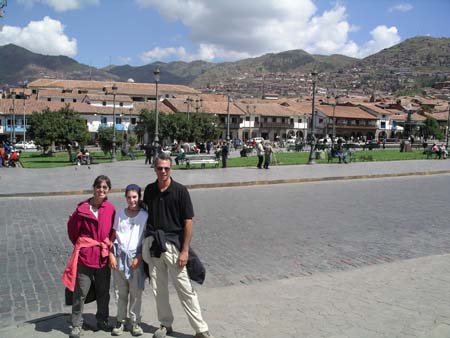 ttiest
city plazas we have seen.
ttiest
city plazas we have seen.
The main cathedral in Cusco (called "La Catedral") was built from 1560-1654 and is one of two dominant churches in the square. It contains over 3,000 original paintings from the 16th and 17th centuries. Most interesting is a painting of the Last Supper that has a distinctive Andean flavor - it depicts a roasted guinea pig on the table and an Incan jug of chicha. The cathedral also has a figure of Christ known as the "Andean Lord" with dark skin.
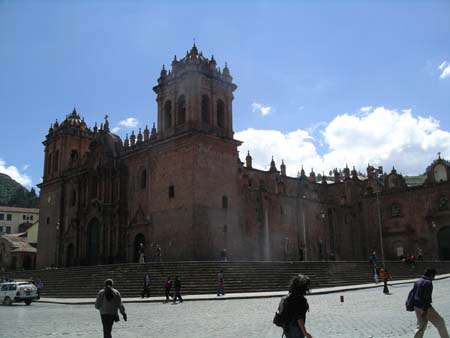 Much
of the cathedral's interior is cedar wood covered in plaster and then laminated
in pure gold. Elaborate twisted and decorated columns and figures of saints
fill the side chapels and alter. Traditional Inca religious symbols are incorporated
into the Christian images to encourage Andean assimilation. The cathedral
also houses the original cross carried by the Spanish conquistadors when they
arrived here in the 1530's.
Much
of the cathedral's interior is cedar wood covered in plaster and then laminated
in pure gold. Elaborate twisted and decorated columns and figures of saints
fill the side chapels and alter. Traditional Inca religious symbols are incorporated
into the Christian images to encourage Andean assimilation. The cathedral
also houses the original cross carried by the Spanish conquistadors when they
arrived here in the 1530's.
Hilda explained how earthquakes in 1650 and then again in 1950 enhanced the
Andean acceptance of Christianity when aftershocks seemed to miraculously
stop after the community organized religious processions in the name of Christ.
The people here are very religious and Hilda told us of the frequent processions
and holidays that occur. 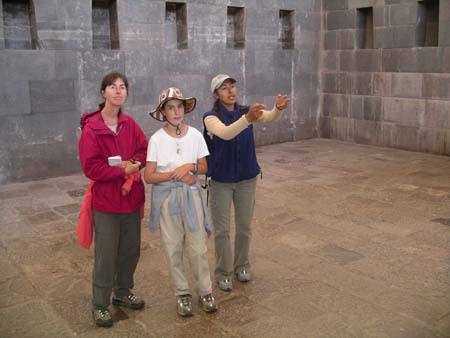
The Temple of the Sun was our next stop. Much of this Inca temple was converted
by the Spanish into a convent and church. Despite this, evidence remains of
the Incan walls and even several complete temples. The famous Temple of Venus
and the Stars is the room (pictured here)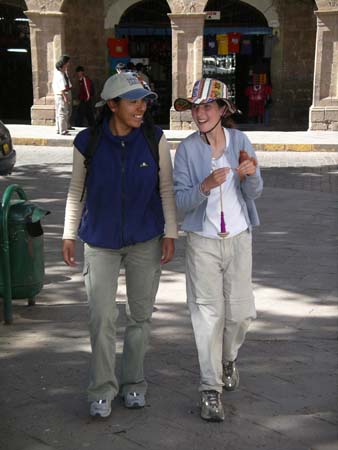 that Altahualpa filled with gold and silver for Pizzaro in an effort to save
his own life.
that Altahualpa filled with gold and silver for Pizzaro in an effort to save
his own life.
A major earthquake in 1950 brought down parts of the church but the Incan foundation survived without damage revealing the original Temple of the Sun where the solid gold idol of Manco Inca was kept until his escape.
After lunch, we headed outside Cusco to visit several of the Inca ruins that
surround the city. On the way, we stopped to admire the beautiful Ausangante
Mountain which is the tallest peak in Cusco at 6,300 meters.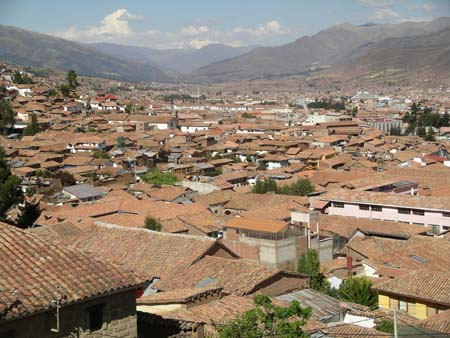
The afternoon was spent exploring the Incan sites of Tambo Machay, Sacsayhuaman
and Qenko. Tambo Machay is a small temple constructed to honor water and includes
a fountain that is still functional today. The exact source of the spring
is still unknown.
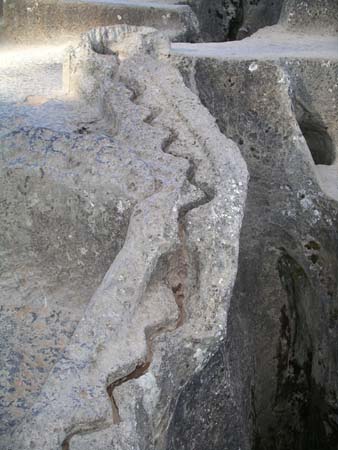 Qenko
means "zigzag", and was named because of the zigzag channel carved
at the top of the rocks where priests would pour water, blood or chicha to
predict the future of the empire. An underground area was also used here to
mummify royals in a manner similar to the Egyptians.
Qenko
means "zigzag", and was named because of the zigzag channel carved
at the top of the rocks where priests would pour water, blood or chicha to
predict the future of the empire. An underground area was also used here to
mummify royals in a manner similar to the Egyptians.
Sacsayhuaman was the largest and most impressive site that we visited here.
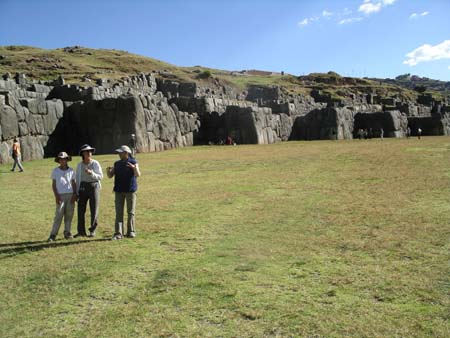 Initially a religious center, it was later converted to a fortress by Manco
Inca to fight off the Spanish. Much of the fortress was destroyed by Manco
Inca as he ordered the large blocks of stone rolled down onto the Spanish.
The site was also used
Initially a religious center, it was later converted to a fortress by Manco
Inca to fight off the Spanish. Much of the fortress was destroyed by Manco
Inca as he ordered the large blocks of stone rolled down onto the Spanish.
The site was also used 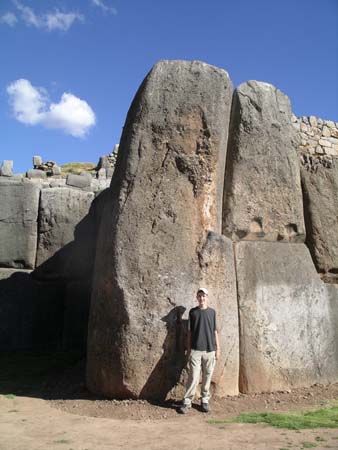 as
a quarry by locals until the 1930's when its historical importance began to
be appreciated. The largest and heaviest stones known to have been used by
the Incas are found at this site and were brought here from a quarry over
5 kilometers away. A zigzag wall at the base of the site is thought to represent
the teeth of a puma. In fact, all of the Inca's major cities are thought to
have been designed in the shapes of animals, and Cusco appears (from the air)
in the shape of a puma.
as
a quarry by locals until the 1930's when its historical importance began to
be appreciated. The largest and heaviest stones known to have been used by
the Incas are found at this site and were brought here from a quarry over
5 kilometers away. A zigzag wall at the base of the site is thought to represent
the teeth of a puma. In fact, all of the Inca's major cities are thought to
have been designed in the shapes of animals, and Cusco appears (from the air)
in the shape of a puma. 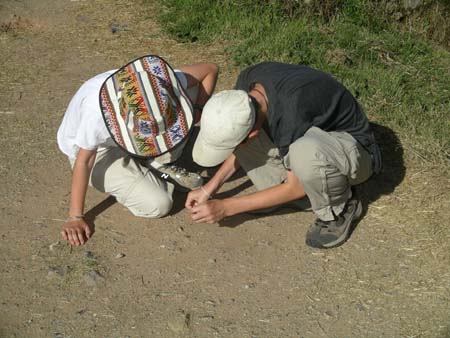
Hilda found a small piece of Incan pottery as we began exploring the Inca ruins this afternoon and this immediately put David and Katie on alert. They spent much of their time digging and looking for pieces of pottery and were actually quite successful. Hilda helped them identify the pottery that they found and then pointed out unique characteristics on each piece including paint, ridges and rounded edges. As soon as we returned to the hotel, David and Katie cleaned all the pieces and then sorted them according to their details. They enjoyed being archeologists for the day and are disappointed that today may have been our last Incan ruins.
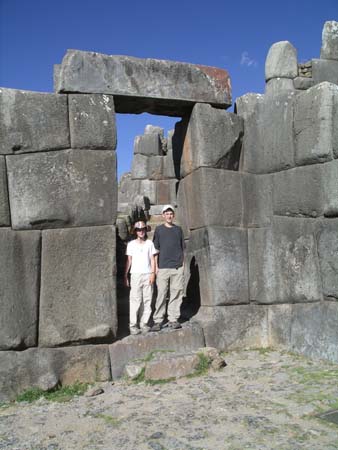 Tomorrow
we plan to have a day to wander the city on our own. We will do some shopping;
visit one of the Incan museums and rest. We have asked Hilda to join us again
on Thursday so that we can visit one last community outside the city.
Tomorrow
we plan to have a day to wander the city on our own. We will do some shopping;
visit one of the Incan museums and rest. We have asked Hilda to join us again
on Thursday so that we can visit one last community outside the city.
